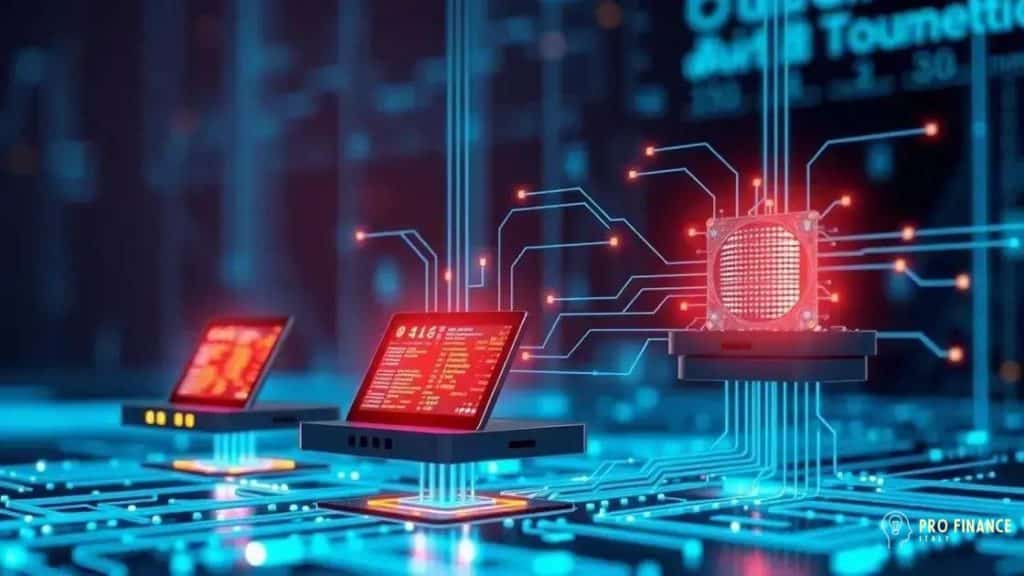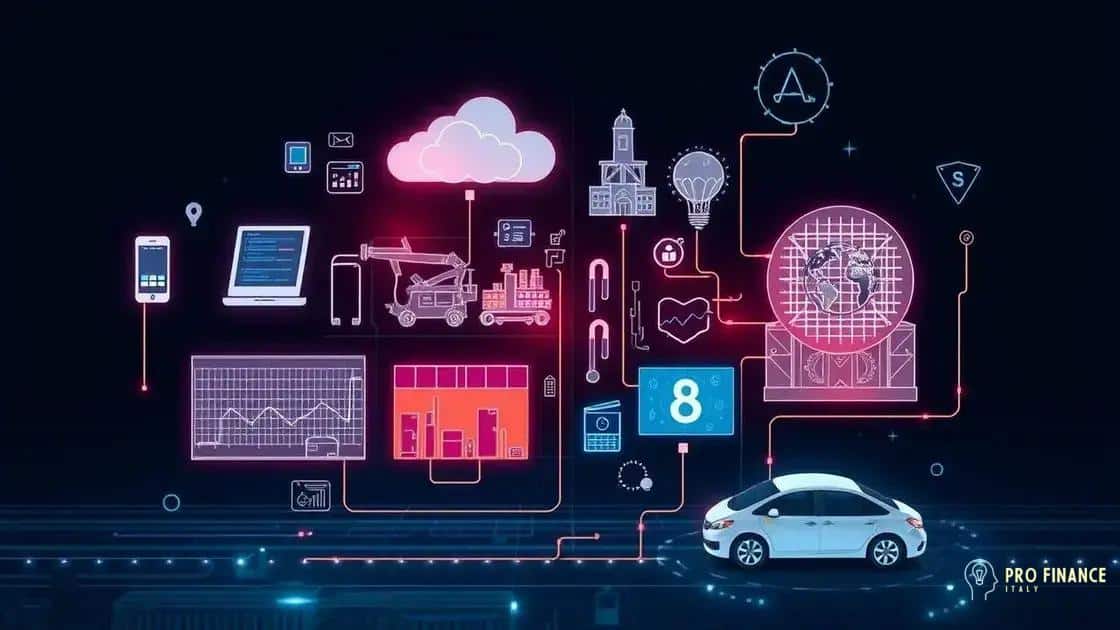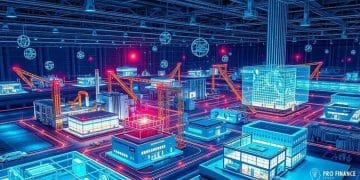Advances in edge computing for real-time data processing

Advances in edge computing for real-time data processing enhance data analysis speed and efficiency by processing data closer to the source, benefiting industries such as healthcare, manufacturing, and retail.
Advances in edge computing for real-time data processing are changing how businesses handle information. Imagine processing data instantly at the source rather than sending it to distant servers. Intrigued? Let’s dive into this transformative technology that’s reshaping industries.
Understanding edge computing and its significance
Understanding edge computing is crucial in this digital era, where data needs to be processed quickly and efficiently. Rather than sending all data to a central server, edge computing allows data to be processed right where it is generated. This shift is significant as it drastically reduces latency and enhances real-time decision-making.
Simply put, edge computing brings computation closer to the data source. For instance, consider smart devices in a factory that collect data on equipment performance. Instead of waiting for the data to be sent to a cloud server, edge devices analyze the data on-site. This leads to faster insights and improved operational efficiency.
Key Benefits of Edge Computing
Implementing edge computing offers several advantages:
- Reduced Latency: Processing data locally speeds up response times.
- Bandwidth Efficiency: Less data needs to be transmitted over the internet.
- Enhanced Security: Keeping data on-site reduces exposure to potential breaches.
By minimizing the distance data travels, businesses can respond to changes and issues instantly. This is particularly important for industries like manufacturing and healthcare, where every second counts.
Real-World Application
Consider a healthcare scenario, where patient monitoring systems collect vital signs. With edge computing, alerts can be generated immediately if a patient’s condition worsens. This capability not only saves time but also can be crucial for a patient’s survival.
Furthermore, edge computing supports the rapid expansion of the Internet of Things (IoT). As more devices connect to the internet, processing data on the edge becomes increasingly essential. It allows organizations to scale their operations efficiently while maintaining high performance and security standards.
Overall, understanding edge computing and its significance is vital for any business looking to stay competitive in a data-driven world.
Key benefits of edge computing for businesses

Many businesses are discovering the key benefits of edge computing. By processing data closer to the source, companies can achieve remarkable improvements in various areas of their operations. In essence, edge computing transforms how data is utilized, providing both speed and efficiency.
One major benefit is reduced latency. When data is analyzed at the edge, decisions can be made much faster, which is critical in environments like manufacturing or healthcare where timing matters. Imagine a factory where equipment failures are detected immediately, allowing staff to address issues without delays.
More Key Advantages
In addition to reduced latency, edge computing offers:
- Increased Bandwidth Efficiency: Less data travels to the cloud, reducing network congestion.
- Enhanced Security: Keeping data on-site limits exposure during transmission, making it less vulnerable to attacks.
- Improved Reliability: Local processing means systems can continue to function even when the internet is down.
These factors contribute to a more stable and secure operational framework, allowing businesses to focus on growth and customer satisfaction. Companies, especially those in retail and finance, can leverage edge computing to enhance customer experiences by providing real-time insights and personalized services.
Furthermore, the cost-effectiveness of edge computing shouldn’t be overlooked. By reducing data transfer costs and the need for extensive cloud infrastructure, businesses can save significantly. This efficiency allows them to allocate resources to other critical areas that can drive innovation and competitiveness.
Ultimately, understanding the key benefits of edge computing is essential for any organization aiming to thrive in a data-driven landscape. By embracing this technology, businesses can better respond to market demands and improve their overall performance.
Real-time data processing: Challenges and solutions
Real-time data processing is crucial for businesses that require quick decisions. However, this process comes with its own set of challenges. Understanding these challenges is the first step in finding effective solutions.
One major challenge is managing the sheer volume of data. As data continues to grow exponentially, businesses often struggle to process it in real-time. Another issue is ensuring data accuracy. When data is processed quickly, there is a risk of missing errors or inconsistencies. These problems can lead to misguided decisions that affect business operations and customer satisfaction.
Common Challenges in Real-Time Data Processing
Some of the most common challenges include:
- High Latency: Delays in data processing can lead to missed opportunities.
- Integration Issues: Combining data from different sources can be complex and error-prone.
- Scalability: As a business grows, the systems must be able to scale efficiently.
- Data Privacy: Ensuring compliance with regulations while processing data is essential.
These challenges require innovative solutions to ensure effective real-time processing. Using advanced technologies like edge computing can significantly mitigate these challenges. By processing data closer to the source, businesses can reduce latency and improve decision-making.
Another effective strategy is implementing robust data management platforms. These platforms can streamline data integration from various sources, making it easier to ensure data accuracy and reliability. Moreover, leveraging machine learning algorithms can enhance the ability to detect anomalies and patterns within data rapidly.
By addressing these challenges with effective solutions, businesses can harness the full potential of real-time data processing. This not only improves operational efficiency but also enhances overall customer experiences.
Use cases of edge computing in various industries

There are many exciting use cases of edge computing across different industries. This technology not only enhances capabilities but also vastly improves efficiency and productivity. Let’s explore some real-world applications that illustrate its potential.
In the healthcare industry, edge computing plays a vital role in remote patient monitoring. For example, wearables connected to edge devices can analyze vital signs in real-time. By processing this data locally, healthcare providers receive immediate alerts about any irregularities, allowing for quick medical interventions.
Manufacturing Applications
In manufacturing, edge computing enables smart factories. Machines equipped with edge devices can monitor their performance and predict maintenance needs. This predictive maintenance reduces downtime, leading to smooth operations and increased profitability. Moreover, data analytics at the edge helps optimize supply chains by analyzing inventory levels on-site.
- Quality Control: Edge devices can conduct real-time inspections, ensuring products meet quality standards.
- Safety Monitoring: Equipment can be monitored for unsafe conditions, enhancing workplace safety.
- Efficiency Tracking: Operations can be fine-tuned based on real-time data analytics.
Another fascinating use case is found in the retail industry. Retailers are using edge computing to enhance customer experiences. In-store devices collect data about customer behavior, allowing businesses to tailor promotions and streamline inventory management. Personalized marketing initiatives can be executed in real time, improving customer satisfaction and loyalty.
Additionally, the transportation sector benefits greatly from edge computing. For instance, self-driving vehicles utilize edge computing to process data from sensors and cameras on-board. This technology enables the vehicle to respond instantly to changing road conditions or obstacles.
As edge computing continues to evolve, its applications in various industries are likely to expand further. By harnessing the power of real-time data processing at the edge, businesses can remain competitive and responsive to market demands.
Future trends in edge computing technology
The future trends in edge computing technology are shaping how industries will function in the coming years. As more devices connect to the internet, the need for efficient data processing at the edge becomes increasingly vital. This evolution promises to enhance everything from manufacturing to healthcare.
One major trend is the continued growth of 5G networks. With faster speeds and lower latency, 5G will significantly improve the effectiveness of edge computing. This technology will enable real-time data processing and seamless communication between devices, enhancing the reliability and speed of various applications.
Integration of Artificial Intelligence
Another key trend is the integration of artificial intelligence (AI) at the edge. By processing data locally, AI algorithms can analyze information in real-time. This capability is particularly beneficial in applications like predictive maintenance and smart home devices. For instance, AI can help manufacturers predict equipment failures before they occur, saving time and resources.
- Smart Cities: Edge computing will support the development of smart city technologies, improving traffic management and resource allocation.
- Enhanced Security: Integrating security measures at the edge will help businesses better protect their networks and data.
- Green Computing: As energy efficiency becomes a priority, edge computing can reduce energy consumption by processing data locally rather than in centralized data centers.
Moreover, edge computing is expected to evolve to support more complex workloads. As industries adopt IoT devices, the demand for advanced computing capabilities at the edge will increase. This trend will drive innovation in hardware and software solutions, making edge computing more powerful and efficient.
Companies are also likely to explore hybrid models that blend edge computing with cloud solutions. These models will provide businesses with the flexibility to manage data and resources based on their specific needs, enhancing performance while keeping costs manageable.
By anticipating these trends, businesses can position themselves to leverage emerging technologies effectively. Understanding the future trends in edge computing technology will be crucial for staying competitive in a rapidly changing landscape.
FAQ – Frequently Asked Questions about Edge Computing
What is edge computing?
Edge computing is a technology that processes data near the source of generation instead of relying on a central data center, reducing latency and improving speed.
How does edge computing benefit businesses?
Edge computing enhances decision-making, increases efficiency, reduces data transfer costs, and provides real-time insights for better operational performance.
In which industries is edge computing commonly used?
Edge computing is widely used in healthcare, manufacturing, retail, and transportation, enabling real-time data processing and improved overall efficiency.
What are the future trends in edge computing?
Future trends include the integration of AI, growth of 5G networks, enhanced security measures, and the adoption of hybrid models combining edge and cloud computing.





